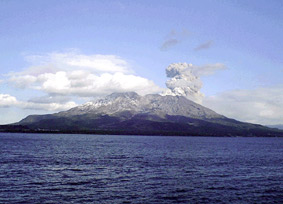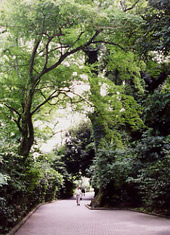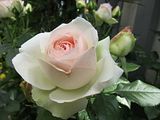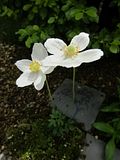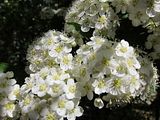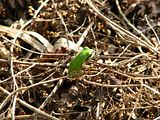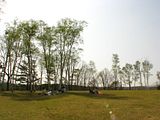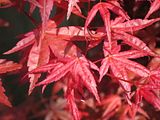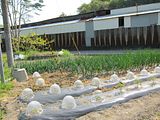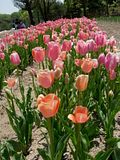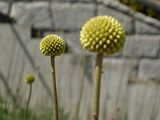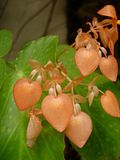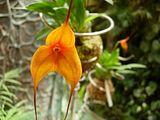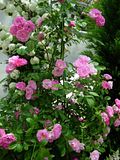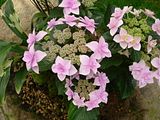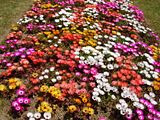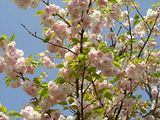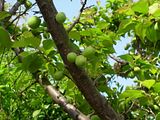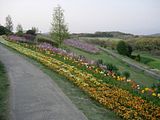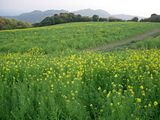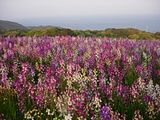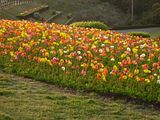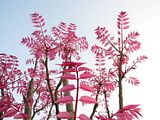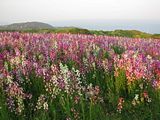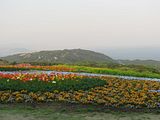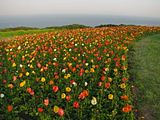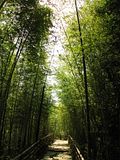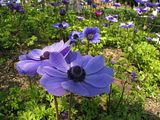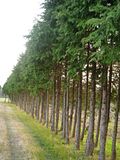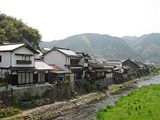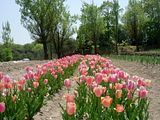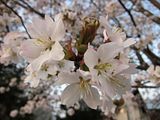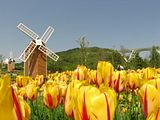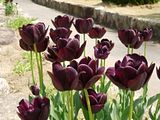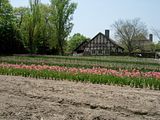One year in June I wanted to see
irises in bloom - Japan's famous
shobu, sung about in poetry and depicted in paintings and ukiyo-e. I opted for
Horikiri Shobuen in the northern part of Tokyo, in what proved to be an eyesore neighborhood, but when I finally reached the garden, I felt happy seeing irises in the rain...

[Horikiri Park, Tokyo]
My first acquaintance with the Horikiri Iris Garden was via the famous blockprint by Hiroshige, in his
Hundred Views of Edo, where one large iris, seen from a low perspective, rises up against a wide sky and distant river. I knew reality would be different, but had not foreseen how much.
It was my own fault: on a rainy day in late June, I went by way of Horikiri Station on the Tobu Line, which means you have to walk over a bleak dike, cross the Arakawa River over an interminably long bridge, walk again over an even bleaker dike, and then find your way through the small town of Horikiri.
It was pouring and on the open bridge the wind teased my umbrella. It was pretty useless, anyway. On the opposite side of the river was a huge highway structure, several roads one above the other, rearing its ugly head on high concrete pillars. The distant thunder of rows upon rows of heavy trucks grumbled through the rain.
After the river I passed a canal with murky water, in which the highway pillars rested. A bunch of flowers was attached to a post, usually a sign someone has died in a traffic accident. I surmised somebody had jumped into the murky canal as a way out of all misery. It were that kind of surroundings.

[Horikiri Park, Tokyo]
The garden, when I finally found it, was a total contrast. It was beautiful. Of course one had to keep the gaze low to avert the surrounding high-rises and the above mentioned highway (standing between garden and river, in what in Hiroshige's print had been an open landscape). But with that small concession, one could enjoy the pleasures of the small garden. Now I was happy with the rain, especially when it changed into a light drizzle. The light drops stuck to the leaves and flowers and dropped into the pools in which the irises stood, adding to an atmosphere of watery softness.
Irises were cultivated in this area at least since the 17th century and local cultivators strove the improve the flowers.
Horikiri has a valuable name in irises. They are still cultivated one by one, by people who make it their vocation. Therefore all flowers have names, written on small boards put next to them. I saw hundreds and hundreds of names, all of a poetical bent, borrowed from literature or history. All these irises were works of love and that showed. I forgot the hideous highway structure and generally ugly surroundings, and just enjoyed the soft and poetical beauty of Horikiri's irises.

[Horikiri Park, Tokyo]
There is even a haiku stone in the garden, with a poem by Matsuno Jitoku (1890-1975), a pupil of Takahama Kiyoshi, who seems to have been something of an "iris poet:"
in sunshine
the whiteness of irises
bedazzles me
tenjitsu ni | shobu no hana no | shiro mabushi Dazzling whiteness, sunshine... that is at least a problem I do not have with my irises in the rain.

[Horikiri Park, Tokyo - lots of water and wetness...]
Address: 2-19-1 Horikiri, Katsushika-ku, Tokyo. Tel. 03-3697-5237
Access: A 10-min. walk from Horikiri Shobuen Station on the Keisei Line.
Hours: 9:00-16:30 (in June: 8:00-18:00). Cl. Monday, Tuesday, 4th Sunday of the month, Year-end and New Year period. NOTE: Open every day during June (iris season).
